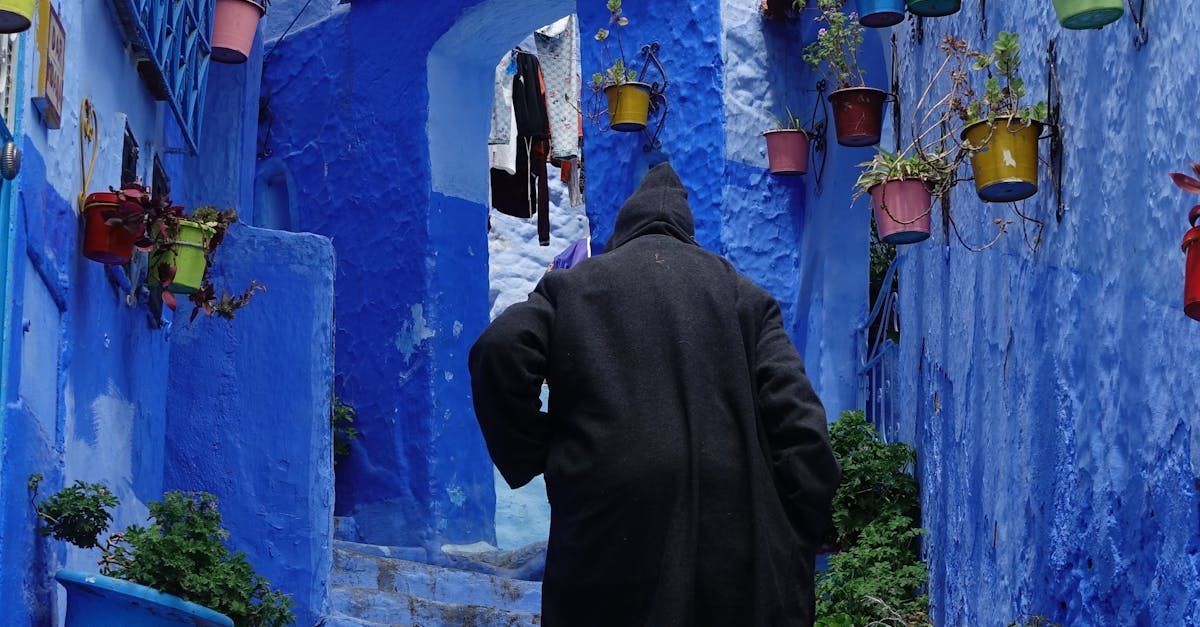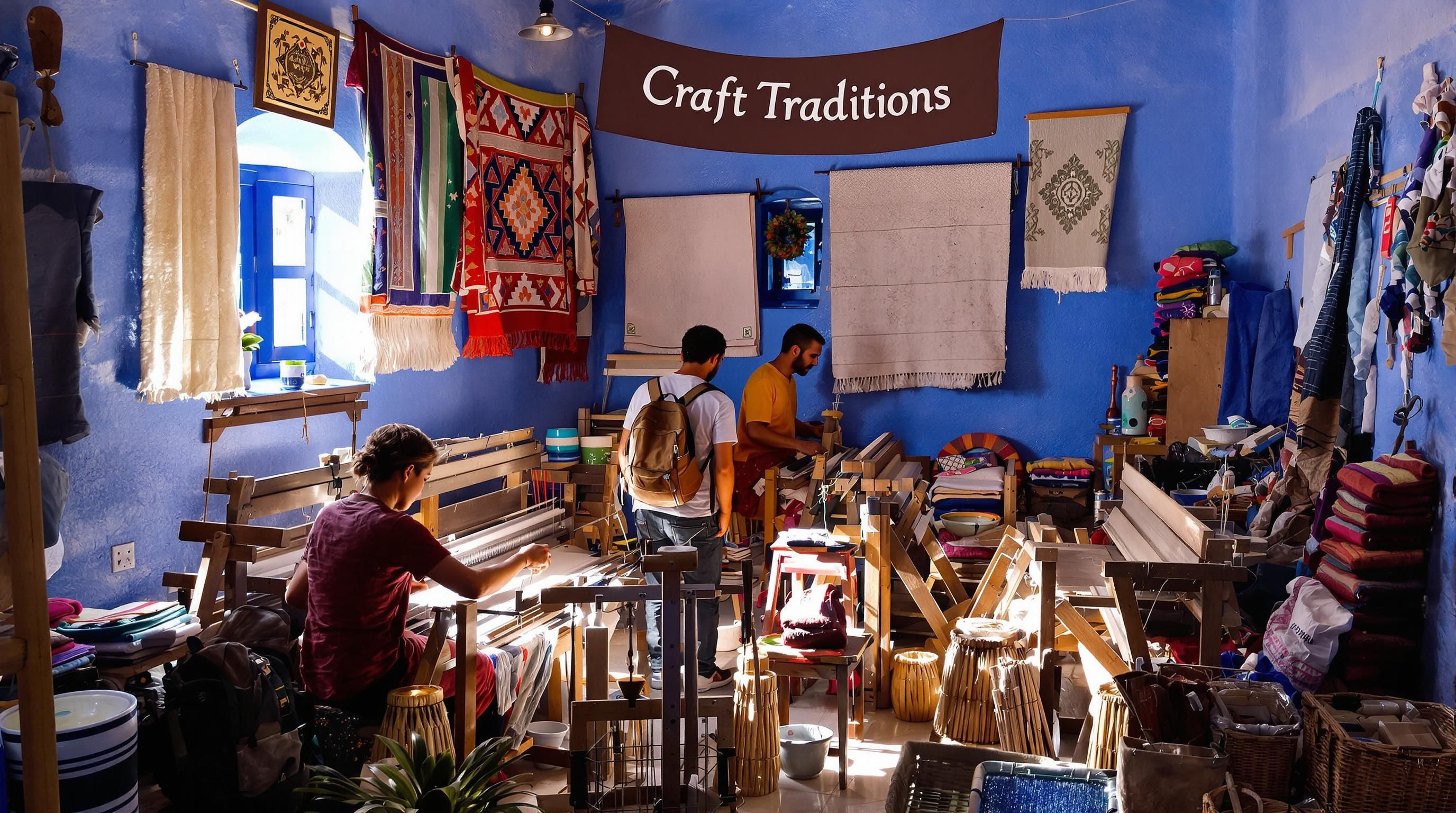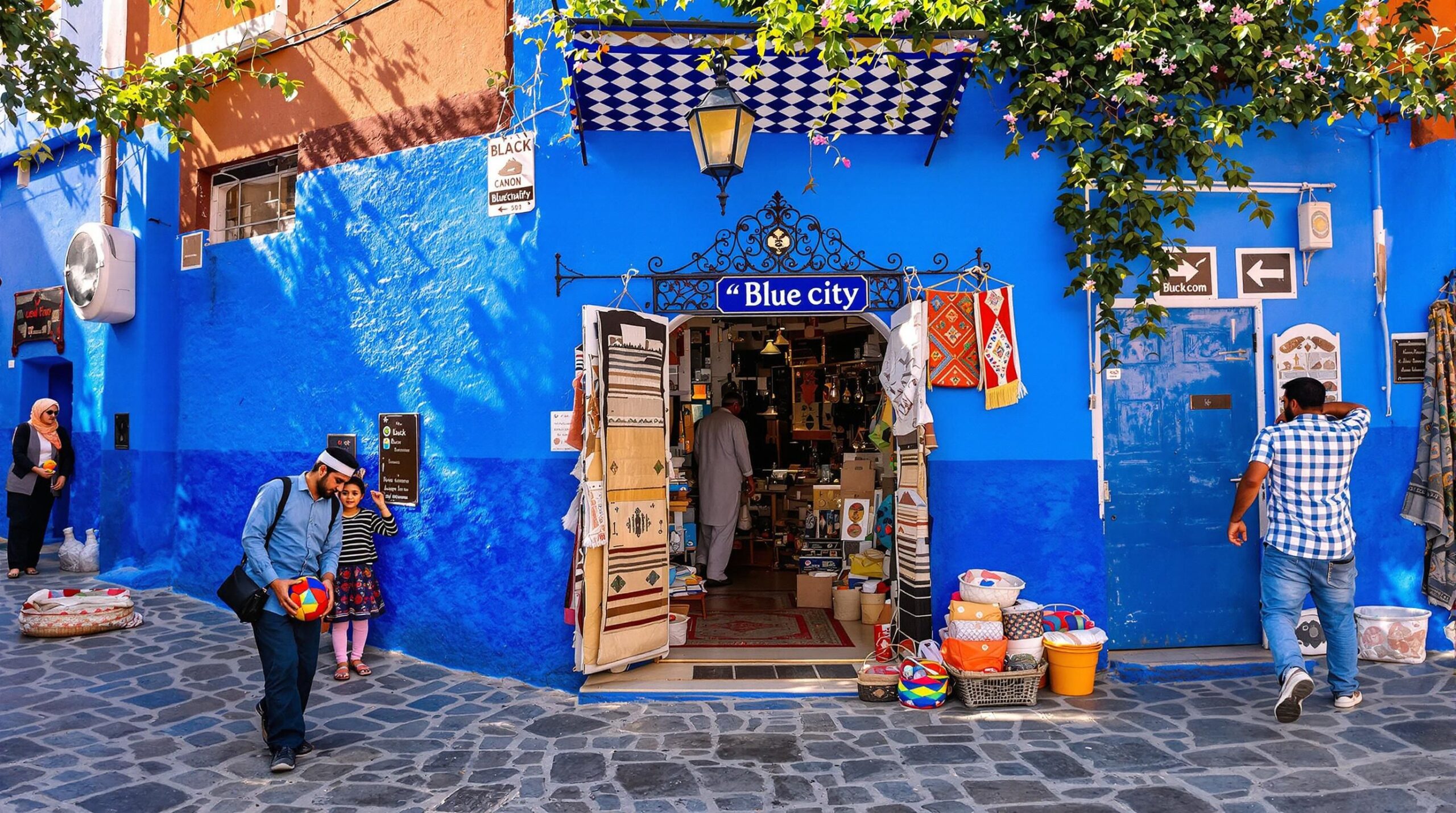Chefchaouen’s medina glows with endless shades of blue, a color so striking it attracts travelers from every corner of the world. Most people snap photos without realizing over 500 buildings are hand-painted every spring to preserve that famous blue. What really catches visitors off guard is that the color is more than just Instagram bait. It tells a deeper story about the city’s spiritual roots and the cultural magic hidden in every winding alley.
Table of Contents
Quick Summary
| Takeaway | Explanation |
| Explore Chefchaouen’s unique blue charm | The city’s blue-washed buildings symbolize cultural and spiritual connections, providing a calming atmosphere. |
| Visit Uta el-Hammam Square | This historic square is the heart of Chefchaouen, perfect for observing local life and ambiance. |
| Engage with local artisans | Interacting with craftsmen in markets offers deep insights into traditional Moroccan crafts and culture. |
| Experience traditional Moroccan cuisine | Enjoy local dishes and hospitality by participating in communal dining and cooking classes. |
| Respect local customs and dress modestly | Engaging respectfully with the culture enhances the experience and fosters meaningful interactions. |
History and Unique Charm of Chefchaouen
Nestled in the Rif Mountains of northern Morocco, Chefchaouen stands as a testament to cultural resilience and architectural beauty. This extraordinary city emerged from a complex historical tapestry that blends Berber, Arabic, and Andalusian influences into a breathtaking urban landscape.
Origins and Founding
Chefchaouen was established in 1471 as a strategic fortress designed to protect the region from Portuguese invasions. Encyclopedia Britannica reveals that the town was founded by Moorish exiles from Spain, who brought with them a rich architectural and cultural heritage. These settlers created a unique settlement that would become a sanctuary for those seeking refuge from political and religious conflicts.
The city’s strategic location in the Rif Mountains allowed it to develop as an important center for local Berber tribes and incoming refugees. Its mountainous terrain provided natural protection, enabling the community to maintain a distinct cultural identity while remaining connected to broader regional networks.

The Blue City: Cultural Symbolism and Artistic Expression
Chefchaouen’s most distinctive feature is undoubtedly its stunning blue-washed buildings, a characteristic that has earned it global recognition. UNESCO World Heritage resources explain that the blue color carries deep cultural and spiritual significance. Jewish refugees who arrived in the 1930s are credited with introducing this vibrant blue palette, which symbolizes the sky and heavenly connections.
The blue hues transform the medina into a mesmerizing canvas, creating an atmosphere of tranquility and spiritual reflection. Every narrow street and whitewashed wall painted in various shades of blue tells a story of cultural blending, artistic expression, and historical resilience. Visitors walking through these streets experience a visual journey that connects them directly to the city’s rich multicultural heritage.
Cultural Preservation and Modern Identity
Today, Chefchaouen represents more than just a picturesque destination. It embodies a living narrative of cultural preservation, where traditional Moroccan architecture coexists with contemporary life. The medina remains a vibrant space where local artisans, craftsmen, and residents continue time-honored traditions while welcoming global travelers.
The city’s unique charm lies not just in its blue walls but in its ability to maintain authentic cultural practices. From traditional handicrafts to local culinary traditions, Chefchaouen offers travelers an immersive experience into a world where history is not merely preserved but actively lived. Learn more about exploring Chefchaouen’s cultural treasures.
As a destination, Chefchaouen invites travelers to step beyond typical tourist experiences and engage with a profound historical narrative painted in mesmerizing blue hues. Its story continues to unfold, offering a compelling testament to cultural resilience, artistic expression, and the enduring spirit of human connection.
Must-See Spots and Things to Do
Chefchaouen offers travelers a remarkable array of experiences that blend cultural immersion, historical exploration, and breathtaking landscapes. The medina presents an extraordinary canvas of attractions that capture the essence of this unique Moroccan destination.
Exploring the Historic Medina and Key Landmarks
Encyclopedia Britannica highlights the Plaza Uta el-Hammam as the central hub of Chefchaouen’s vibrant urban life. This historic square serves as the perfect starting point for travelers wanting to understand the city’s rhythm. Surrounded by traditional cafes and restaurants, visitors can observe local life while enjoying authentic Moroccan mint tea.
The Kasbah museum stands as another critical attraction within the medina. UNESCO World Heritage resources emphasize its significance as a preserved historical fortress that offers deep insights into the region’s architectural and cultural heritage. Travelers can explore its intricate courtyards, exhibits showcasing local crafts, and panoramic views of the surrounding blue-washed cityscape.
Architectural enthusiasts will appreciate the Grand Mosque, an exquisite example of traditional Moroccan Islamic design. While non-Muslims cannot enter, the exterior provides a stunning architectural study with its distinctive geometric patterns and historical significance.
Artisan Crafts and Cultural Experiences

The medina of Chefchaouen is renowned for its rich artisanal traditions. Academic research from JSTOR underscores the importance of local handicrafts in maintaining cultural identity. Visitors can explore numerous workshops and small stores selling traditional Moroccan textiles, leather goods, ceramics, and the region’s famous woolen blankets.
Local markets offer an immersive experience where travelers can interact with artisans and understand traditional crafting techniques. The narrow blue-painted streets serve as perfect backdrops for purchasing unique souvenirs and experiencing genuine cultural exchange. Photographers will find endless opportunities to capture the vibrant scenes of craftspeople at work.
Natural Landscapes and Outdoor Adventures
Beyond the medina’s blue walls, Chefchaouen is surrounded by stunning natural landscapes in the Rif Mountains. Hiking trails offer adventurers breathtaking views and opportunities to explore the region’s biodiversity. The nearby Talassemtane National Park provides excellent trekking routes through cedar forests and rugged mountain terrain.
Local guides can arrange day trips that combine cultural exploration with outdoor experiences. These excursions might include visiting nearby Berber villages, exploring hidden waterfalls, or experiencing traditional mountain hospitality. Learn about more incredible Moroccan travel experiences.
Chefchaouen’s attractions extend far beyond mere sightseeing. Each corner of this blue city tells a story, inviting travelers to immerse themselves in a rich tapestry of culture, history, and natural beauty. Whether wandering through historic streets, engaging with local artisans, or exploring mountain landscapes, visitors will discover an unforgettable Moroccan experience that resonates long after their journey ends.
Best Ways to Enjoy the Medina for Every Traveler
Chefchaouen’s medina offers a unique experience for every type of traveler, blending cultural immersion, sensory exploration, and personal discovery. From solo adventurers to family groups, the blue-washed streets provide multiple avenues for unforgettable experiences.
Guided Walking Tours and Cultural Exploration
The Moroccan National Tourist Office recommends exploring the medina through structured walking tours that reveal the city’s hidden narratives. Professional local guides can transform a simple walk into an immersive journey through centuries of cultural heritage. These tours typically begin at Uta Hammam Square, the medina’s central gathering point, and wind through narrow blue-painted streets.
Travelers can choose from various specialized tour experiences. Photography enthusiasts will appreciate routes designed to capture the most photogenic corners of the blue city. Cultural historians can opt for in-depth explorations that delve into architectural details and historical significance. Families with children might prefer more interactive tours that include storytelling and hands-on cultural experiences.
Here is a comparison table summarizing different ways to explore the medina, highlighting their features and best suited traveler types:
| Exploration Approach | Features | Best For |
| Guided Walking Tours | Expert insights, historical narratives, set routes | First-timers, history buffs |
| Photo Tours | Focus on photogenic spots, timing for light | Photographers |
| Interactive Family Tours | Storytelling, hands-on activities | Families, children |
| Self-guided Exploration | Freedom, flexible pace, use of apps/maps | Independent travelers |
| Thematic Cultural Experiences | Cooking classes, crafts workshops | Culture enthusiasts |
Authentic Local Experiences and Cultural Interactions
Wikipedia highlights Uta Hammam Square as a critical hub for experiencing local life. This vibrant marketplace allows travelers to engage directly with local artisans, sample traditional cuisine, and observe daily rhythms. Visitors can participate in cooking classes, learn traditional craft techniques, or simply sit in a local cafe and absorb the atmosphere.
Traditional hammams offer another profound cultural experience. Wikivoyage notes these bathhouses provide an authentic glimpse into local wellness traditions. Travelers can choose between communal public baths and more private experiences, each offering a unique perspective on Moroccan social and cultural practices.
Personalized Medina Exploration Strategies
For independent travelers seeking a more personal connection, self-guided exploration offers unparalleled freedom. Strategic approaches can enhance the medina experience. Early morning walks provide soft lighting and fewer crowds, ideal for photography and quiet reflection. Evening strolls showcase the medina’s magical transformation under ambient lighting.
Technology can augment the exploration. Digital maps, translation apps, and cultural guides can help travelers navigate confidently. Downloading offline resources ensures connectivity challenges don’t interrupt the experience. Discover comprehensive Morocco travel tips to prepare for your medina adventure.
The medina of Chefchaouen is more than a destination it’s an invitation to personal discovery. Whether you’re a culture enthusiast, adventure seeker, or casual traveler, the blue streets offer a canvas for unique experiences. Each turn reveals a new perspective, each interaction tells a story, and every moment becomes a treasured memory of Moroccan hospitality and cultural richness.
Remember that respect, curiosity, and openness are the best companions when exploring this extraordinary urban landscape. Engage with locals, embrace unexpected encounters, and allow the medina’s magic to unfold naturally.
Tips for Shopping, Dining, and Local Culture
Chefchaouen’s medina offers travelers a rich tapestry of cultural experiences, where shopping, dining, and local traditions intertwine to create a vibrant and immersive journey. Understanding the nuanced approach to these aspects can transform a simple visit into an extraordinary cultural exploration.
Navigating Local Markets and Artisan Shopping
Columbia University research highlights the profound cultural significance of shopping in Moroccan medinas. In Chefchaouen, the marketplace represents more than a commercial space it’s a living museum of local craftsmanship. Visitors should approach shopping as a cultural dialogue, not just a transaction.
Traditional markets specialize in unique local products. Handwoven textiles, intricate ceramics, leather goods, and woolen blankets showcase the region’s rich artisanal heritage. Bargaining is an expected part of the shopping experience, but it should be approached with respect and friendly negotiation. Engaging with artisans, asking about their craft, and showing genuine interest often leads to more meaningful interactions and fair pricing.
Photography etiquette is crucial. Always ask permission before taking pictures of artisans or their work. Some may appreciate the attention, while others might prefer privacy. A small tip or purchase can be a respectful way to acknowledge their craft and seek permission for photographs.
Below is a checklist-style table summarizing essential shopping etiquette and cultural tips for Chefchaouen’s markets:
| Etiquette/Tip | Recommended? | Notes |
| Bargain respectfully | Yes | Negotiation is expected; maintain friendly tone |
| Engage with artisans | Yes | Ask about their crafts for richer interactions |
| Ask permission before photographs | Yes | Essential for privacy and respect |
| Tip for photos/purchases | Optional | Appreciated gesture for artisans |
| Accept fixed price without asking | No | Bargaining is part of the market culture |
| Rush through stalls | No | Take time to appreciate crafts |
Culinary Experiences and Dining Etiquette
The Library of Congress’ digital collection provides insights into the social fabric of Moroccan medina life, where dining is a communal and deeply cultural experience. Chefchaouen offers a unique culinary landscape that blends Berber, Arabic, and Andalusian influences.
Local restaurants and street food vendors offer authentic experiences. Traditional dishes like tagine, couscous, and harira soup reflect the region’s culinary depth. Mint tea is more than a beverage it’s a symbol of hospitality. When invited to share tea, accepting is considered a gesture of respect and friendship.
Dining etiquette involves some key considerations. Eating with the right hand is traditional, and communal dishes are common. Modest dress is appreciated, especially during Ramadan. Tipping is customary but not mandatory typically 10% in restaurants is appropriate.
Cultural Sensitivity and Local Interactions
Respectful engagement is the cornerstone of meaningful cultural experiences. The medina is not just a tourist destination but a living community with deep-rooted traditions. Dress modestly, particularly when visiting religious sites or more conservative areas. Women might consider covering shoulders and knees, while men should avoid overly casual attire.
Language can be a powerful bridge. Learning a few basic Arabic or Berber phrases demonstrates respect and often leads to warmer interactions. Simple greetings like “Salam Alaikum” (peace be upon you) can open doors to genuine connections.
Uncover more about authentic local experiences to enhance your understanding of Chefchaouen’s rich cultural landscape. The medina is an invitation to slow down, observe, and connect. Every interaction is an opportunity to learn, every market stall tells a story, and every meal is a celebration of local traditions.
Remember, the most enriching travel experiences come from curiosity, respect, and a willingness to step outside your comfort zone. Chefchaouen’s medina offers a masterclass in cultural immersion for those ready to embrace its unique rhythms and traditions.
Frequently Asked Questions
What is the significance of the blue color in Chefchaouen?
The blue color of Chefchaouen’s buildings carries deep cultural and spiritual meaning, symbolizing the sky and heavenly connections. It was introduced by Jewish refugees in the 1930s and adds to the city’s unique charm.
What are the must-see attractions in Chefchaouen’s medina?
Key attractions include Uta el-Hammam Square, the Kasbah museum, and the Grand Mosque. Each offers a glimpse into the city’s rich history, culture, and stunning architecture.
How can I experience local culture in Chefchaouen?
Engage with local artisans in the markets, participate in cooking classes, and visit traditional hammams. Interacting with locals and immersing yourself in cultural practices will enrich your visit.
What tips should I follow when shopping in Chefchaouen’s markets?
Approach shopping as a cultural dialogue; bargaining is expected but should be done respectfully. Engage with artisans about their crafts, and always ask permission before taking photographs.
Unlock the True Magic of Chefchaouen with Expert Local Guides
Feeling lost among Chefchaouen’s winding blue alleys, unsure how to find authentic connections or the best local gems? Many travelers arrive hoping to understand the deeper stories behind the city’s vibrant medina or to engage honestly with artisans, but they often miss out without a trusted insider’s help. The article highlights common challenges such as navigating bustling markets, bridging the cultural gap with locals, and structuring your day so each moment feels both enriching and stress free.
Why leave your Chefchaouen adventure to chance when you can step into the heart of Moroccan culture with confidence? TopMoroccoTravel.com designs journeys that make every corner of the blue city accessible, meaningful, and memorable. Explore custom guided tours and exclusive experiences tailored for every type of traveler. Enjoy seamless planning, authentic interactions, and 24/7 support. Start planning your dream trip with TopMoroccoTravel.com and make sure every shade of Chefchaouen blue becomes part of your story. Ready to begin? Unlock your unforgettable Morocco journey today.
Recommended
-
Chefchaouen Travel Guides: Best Things To Do In Chefchaouen
-
Marrakech Travel Guide: Explore Morocco’s Vibrant Heart – Top Morocco Travel
-
Marrakech Travel Guides: Best Things To Do In Marrakech
-
Morocco Travel Itinerary: Your Guide to an Unforgettable Adventure – Top Morocco Travel
-
10 Hidden Vacation Destinations to Explore – Vacationspotter.com






Comments are closed